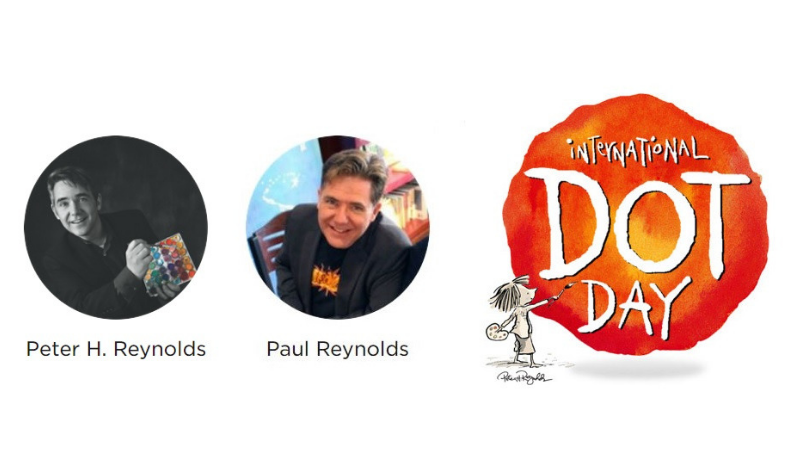The only real guideline for Dot Day is that folks read The Dot and then express themselves in any way they are inspired to, whether that means
- creating a dot
- building a dot gallery
- collaborating on a dot gallery with teachers/parents
- animating a dot
- writing a story about being brave and making your mark
- going on a dot photo safari to find dot shapes in our world
- writing a dot song
- doing a dot-inspired dance
- putting on a live performance of The Dot,
- [and] more!
How you celebrate Dot Day is up to you
— and your friends.
Peter H. Reynolds
International Dot Day—a global celebration of creativity, courage, and collaboration—began when teacher Terry Shay introduced his classroom to Peter H. Reynolds’s book The Dot on September 15, 2009.
The Dot is the story of a caring teacher who dares a doubting student to trust in her own abilities by being brave enough to “make her mark.” What begins with a small dot on a piece of paper becomes a breakthrough in confidence and courage, igniting a journey of self-discovery and sharing that has gone on to inspire countless children and adults around the globe.
We are fortunate enough to have the Reynolds brothers, Peter H. and Paul, as speakers at our General Session at the 2018 NCTE Annual Convention in Houston. This session will take place on Sunday, November 18, from 12:00 p.m.–1:30 p.m. At #NCTE18, celebrate students’ voices and the impact they make on the world. Learn more and register here.
The following are resources from NCTE and ReadWriteThink.org that celebrate the 15th anniversary of The Dot and move forward the idea of International Dot Day and the story’s powerful themes of bravery, creativity, and self-expression.
Studies of the effects of reading fiction on the human brain have proven that children can learn these skills of bravery and resilience by reading about characters who are on that journey. Read more in this article from Voices from the Middle.
Students aren’t the only ones who need to be brave. As shared in this article “Curriculum can be reimagined—for even just one student—to represent this fairness. So can classroom norms, traditions, and systems. This work requires creativity and bravery. This kind of institutional creativity or professional bravery is not a trait ascribed at birth. They are attributes that can be learned, practiced, reimagined, and refined. As educators, this is where we excel.”
Teachers can cultivate, nurture, and encourage the growth of creativity. Educators can do it with a positive attitude and a different kind of thinking—enabling them to ask just the right questions and to develop a creative environment. Read more in this article from English Leadership Quarterly.
Use independent, imaginative artwork and varied writing prompts to assess understanding of a given topic for a student body with differentiated needs with this activity from ReadWriteThink.org.
Invite students to express themselves verbally, visually, and musically by creating multimodal autobiographies, exchanging ideas with other students and sharing important events in their lives through interactive presentations.
Graphic narratives have the ability to transform the ways we think about reading and writing in language arts classrooms and the ways students think about themselves as readers and writers. Read more in this article from Language Arts.
What can you do to help your students make their mark?

